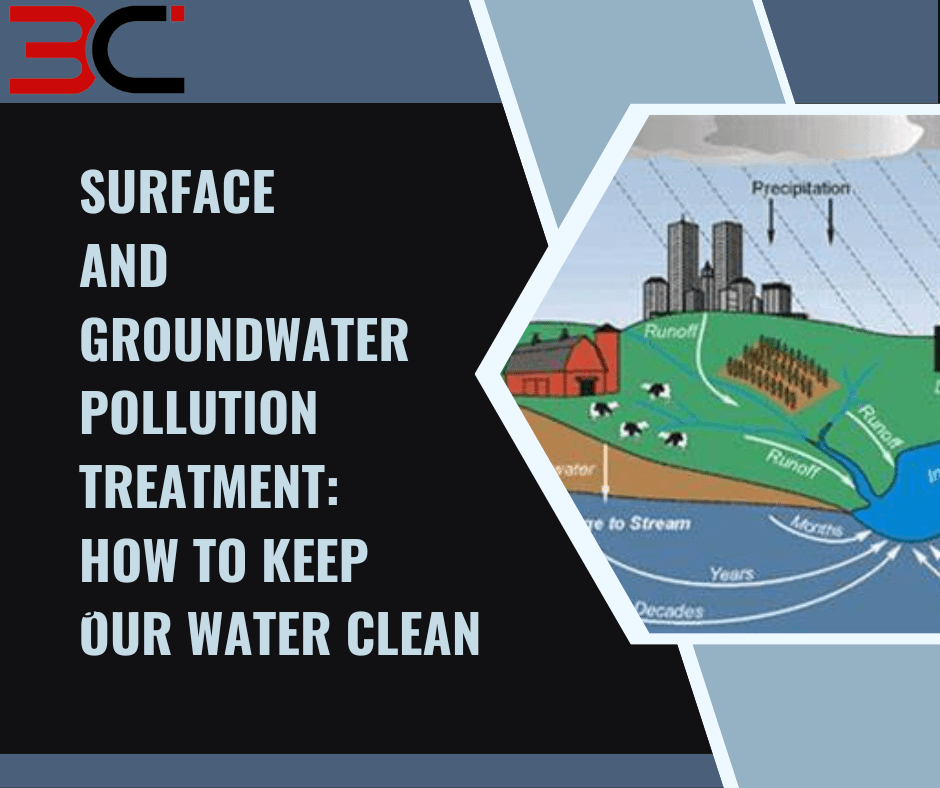Groundwater pollution treatment is a vital process for keeping our water sources clean and healthy.
As we know, only 2.5% of the world’s water is freshwater. Groundwater and surface water contributions totaled 0.4% and 30.1%, respectively. It is important to prevent groundwater pollution to ensure this precious resource is not contaminated. Fortunately, there are effective treatments for groundwater pollution that can help us protect our lakes, rivers, and other water sources.
We will examine the various methods for treating groundwater pollution and maintaining the purity of our water in this extensive blog post.
What is Groundwater Pollution?
Groundwater pollution is the contamination of underground water reserves that can spread and affect other sources of water, such as rivers and lakes. Groundwater pollution can occur naturally due to the movement of pollutants such as minerals and organic material. However, it can also be caused by human activities, such as improper disposal of waste, sewage, or industrial effluent.
Figure: Groundwater contamination in 3D (source: Groundwater Pollution and Remediation)
What is Surface water Pollution?
Surface water pollution is a sort of contamination that happens above ground, such as in seas, streams, ponds, and rivers. Runoff from dirty precipitation into surrounding water sources causes these waterways to become polluted.
Sewage leaks and animal factory waste are other sources of surface water contamination. If you drink such polluted water even for a little while, you will have health issues like diarrhea, typhoid, and hepatitis.
Despite having one of the cleanest drinking water systems in America, the use of polluted water is thought to be the cause of sickness or disease for an estimated 4 to 32 million people around the world.
Figure: hydrologic cycle (source: Groundwater Pollution and Remediation)
Both surface and groundwater pollution are important environmental issues because they can lead to significant health risks and damage to natural ecosystems. The effects of such pollution may be difficult to detect.
That is because it can take years for pollutants to travel through the subsurface and reach sources of drinking water. As a result, it is very important to identify the sources of surface and groundwater pollution in order to prevent further contamination.
Causes of Surface and Groundwater Pollution
The reasons for groundwater pollution are dynamic. There are natural elements responsible for this type of pollution. On the other hand, artificial human-made elements are also polluting the groundwater surface.
Let’s take a look at a few of the reasons –
- Industrial waste disposal – Factories, power plants, and mines often release toxic chemicals into the ground.
- Sewage leakage – A leakage from sewage pipes and septic tanks can cause groundwater contamination.
- Agricultural activities – Fertilizers, pesticides, and animal waste used in farming can contaminate the groundwater.
- Urban runoff – Hazardous chemicals such as oil and gasoline can leak into the groundwater when stormwater is not properly managed.
- Leaky landfills – Landfills are designed to contain solid waste, but they can be prone to leaks that can pollute the groundwater.
- Groundwater extraction – Over-extraction of groundwater can lower the water table, leading to contamination from nearby sources.
- Poorly constructed wells – If wells are not constructed correctly, they may allow contaminants to enter the groundwater.
- Spills or accidents – Even a small spill or accident can have an impact on the local environment, particularly if it contaminates a body of water or soil near a source of drinking water.
- Natural disasters – Floods, hurricanes, earthquakes, and other natural disasters can lead to significant levels of contamination in the local environment.
- Unregulated businesses – Businesses that do not follow regulations regarding the disposal of their waste products may be a source of contamination for local waterways and aquifers.
- Aging infrastructure – Aging sewers, pipelines, and other infrastructure may also be vulnerable to leaks, which can introduce contaminants into the environment.
Let’s take a look at the following table that indicates the potential sources of surface and groundwater pollution –
| Category | Types of contaminants | Source of contamination |
| Residential | Air pollution Household waste Salt for street de-icing Furniture stripping/refinishing | Septic tank Fuel oil Air pollution Sewer network |
| Municipal | Municipal incinerators Wastewater treatment plants Municipal sludge spreading on land Wastewater treatment plants’ effluents | Streets and parking lots Road maintenance depot Municipal landfills |
| Commercial | Construction areas Golf courses Dry cleaners Cemeteries Car washes | Metal plating Research laboratories Railroad tracks Recycling facilities Medical institutions |
| Industrial | Chemical industry Electronics manufacture Metalworking shops Hazardous spills | Metal fabricators Petroleum production Storage tanks Pipelines |
| Agriculture | Animal feeds Irrigation sites Sludge reuse Live stocks waste | Manure spreading areas Pesticides Chemical spills Fertilizer storage |
Treatments for Surface and Groundwater Pollution
Surface and groundwater are vital supplies of water for drinking. They are also a vital resource for industry, farming, and natural habitats. However, pollution and misuse pose a danger to these resources. Numerous institutions contend that these resources need legal safeguards and more oversight.
When it comes to treating either surface or groundwater pollution, there are two main approaches –
- Remediation
- Prevention
Let’s see how these 2 approaches can prevent groundwater pollution,
Remediation –
It involves identifying and addressing the source of the contamination, as well as monitoring and cleaning up the affected area. The most common remediation techniques include physical, chemical, and biological treatments. For instance, the use of pumps and skimmers, aeration, and bioremediation. In some cases, soil or sand may be used to absorb contaminants and filter them out of the groundwater.
Prevention –
This is the second approach to reducing surface and groundwater pollution. This involves the followings –
- Limiting the number of pollutants entering the water by controlling runoff.
- Treating wastewater before discharge.
- Reducing agricultural runoff using conservation practices such as crop rotation, cover crops, and buffer strips.
- Avoiding activities such as dumping hazardous materials into the ground or disposing of pollutants in storm drains.
Aside from the above 2 approaches, individuals and businesses should be aware of the risks associated with groundwater contamination. They need to take steps to reduce their environmental impact. These steps include –
- Following regulations related to the disposal of hazardous materials.
- Performing regular maintenance on any equipment that uses or produces pollutants.
- Using fewer chemicals in their home or business operations.
- Getting rid of any waste that could contaminate groundwater.
Groundwater Pollution Classification
Groundwater pollution is classified differently depending on the source of the pollutant and its effects. Sources of groundwater pollution include agricultural runoff, septic systems, road salt, urban runoff, and industrial waste.
Depending on the pollutant’s source, groundwater pollution can be classified as –
- Point-source pollution occurs when a pollutant has one identifiable source (i.e., a factory).
- Nonpoint-source pollution occurs when a pollutant has multiple sources that can’t be easily identified (i.e., agricultural runoff).
Groundwater pollution can also be classified based on its effects on human health. For example, there is primary and secondary contamination. Primary contamination includes chemicals like arsenic, fluoride, lead, mercury, and radon.
Figure: The main process (source: Groundwater Pollution and Remediation)
Secondary contamination includes things like viruses, bacteria, fungi, parasites, and toxins. While secondary contamination is more likely to result in acute health issues like gastrointestinal illness, primary contamination can result in long-term health issues like cancer.
Finally, groundwater pollution can also be classified by its concentration. Groundwater can be affected by low-level concentrations of pollutants (i.e., trace amounts) or high concentrations (i.e., hazardous levels). Different treatments may need to be used depending on the concentration of pollutants found in the groundwater.
Mechanisms of groundwater pollution
Groundwater pollution is caused by a variety of sources. Pollutants can enter the groundwater through direct disposal of hazardous waste, seepage from landfills, agricultural runoff, and other sources. Once pollutants enter the groundwater, they must be transported to their destination. The transport of pollutants within the soil-rock-groundwater system requires a mechanism, or a combination of mechanisms, to spread throughout the system.
Figure: Contaminant plume (source: Groundwater Pollution and Remediation)
The fate of the pollutant is determined by 3 types of processes. These are as follows –
- Physical process – This is responsible for the physical movement of the pollutant in the groundwater system. Examples are advection, dispersion, evaporation, filtration, and degassing.
- Geochemical process – This is responsible for the chemical transformation of the pollutant. For example, acid-base reactions, adsorption-desorption, ion exchange, oxidation-reduction, precipitation-dissolution, retardation, and complexation.
- Biochemical processes – This is responsible for the biological degradation of the pollutant. Transpiration, bacterial respiration, decay, and cell synthesis are some examples.
The transport equation is used to determine how a contaminant moves within a groundwater system. This equation considers mass conservation over an elemental volume of the aquifer. Additionally, it includes an advection term, a dispersion term, and a source/sink term.
Transport Equation
Here –
C = Concentration of the contaminant
t = Time
x = Distance
q = Relevant coefficient
v = Water flow velocity
D = Hydrodynamic dispersion coefficient
Diffusion is the most important process in aquifers, whereas advection is more important for contaminant transport in sedimentary aquifers. The speed at which contaminants move through the soil-rock-groundwater system is determined by the characteristics of the aquifer. Understanding these mechanisms is crucial to effectively treating contaminated groundwater.
Final Words
In conclusion, surface and groundwater pollution classification is important to understand the causes and effects of contamination. At the same time, it is required for developing appropriate treatment strategies.
With proper classification and treatment techniques, surface and groundwater pollution can be managed and prevented. Ultimately, we can keep our water clean and safe for consumption.

